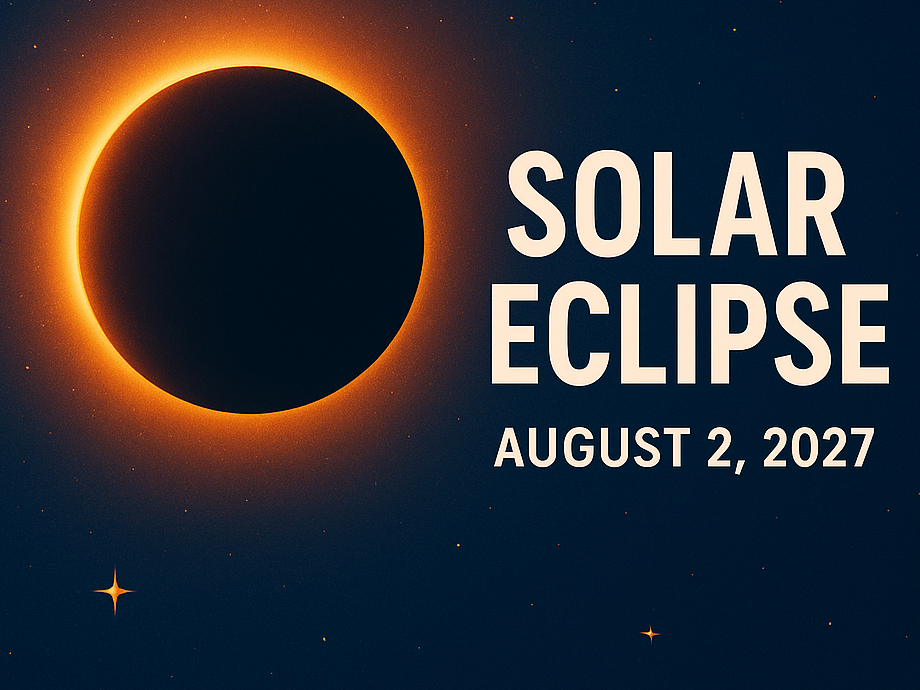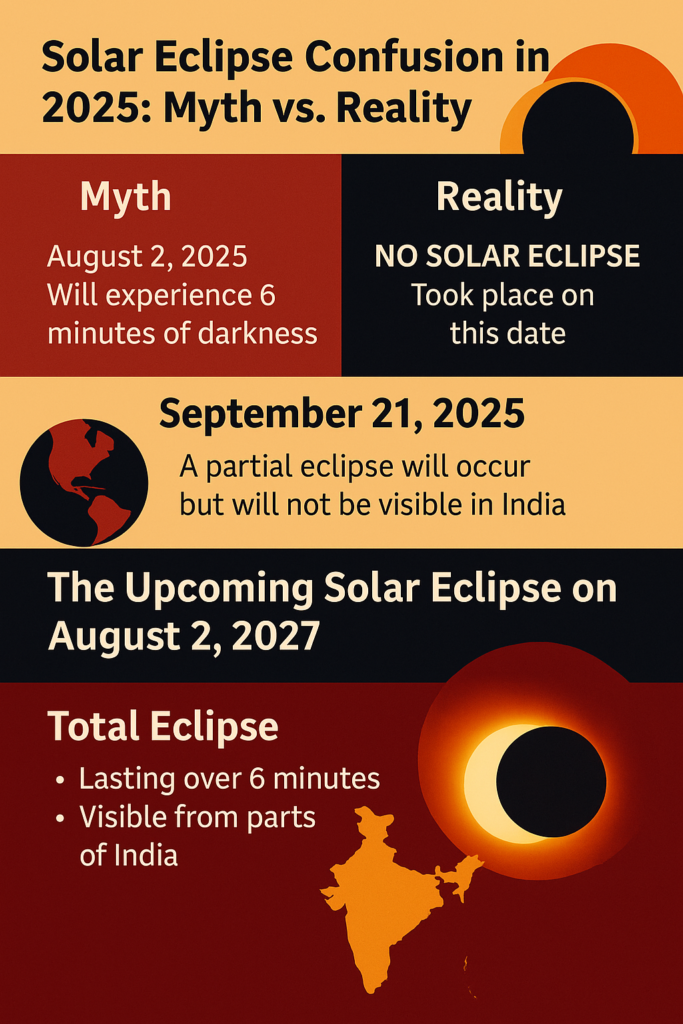Introduction: The Viral Confusion of August 2, 2025

Social media recently buzzed with alarming claims: a massive solar eclipse on August 2, 2025, causing global darkness for six minutes. Newspapers and astrology forums even dubbed it the “century’s longest Surya Grahan”—but that is purely misinformation .
In reality:
- No solar eclipse occurs on August 2, 2025.
- The next partial eclipse is on September 21, 2025, not visible from India.
This post aims to clarify the confusion, explain the real upcoming event, and provide exam-relevant science insight in a clear, reader-focused manner.
🚫 Debunking the 2025 Eclipse Rumor
The False Alarm
- Viral posts suggested a six-minute total eclipse on August 2—but astronomers at NASA and Indian observatories confirm there is no eclipse on that date.
- The confusion stems from errors in forwarding information meant for the August 2, 2027 eclipse .
Why India Will Observe Nothing
- Since the celestial alignment isn’t happening in 2025, there’s no visible or partial eclipse over India, making any observance unnecessary .
- Hindu rituals like Sutak period are strictly tied to visible eclipses—no eclipse, no rituals required.

What’s Real? The Upcoming Solar Eclipse on 2 August 2027
An Authentic Phenomenon
- A rare total solar eclipse is scheduled for August 2, 2027, promising up to 6 minutes and 23 seconds of totality—the longest visible from land this century.
- The path of totality will cross countries in North Africa, Southern Europe, and the Middle East.
India’s Viewing Scenario
- India will observe a partial eclipse, mainly visible in western states like Rajasthan, Gujarat, Maharashtra, and Goa .
- Timings from India will be around 3:34 PM IST to 5:53 PM IST, with no period of full darkness .
📘 Solar Eclipse Confusion in 2025: Myth-Busting Guide + What to Expect in 2027
Why This Matters
Solar eclipses fascinate millions. But misinformation can cloud real science, especially when viral posts suggest blackout events that don’t exist. Recently, social media and astrology groups claimed a “six-minute blackout” eclipse on August 2, 2025—sparking rituals and widespread panic.
But here’s the truth:
- No eclipse happened on that date.
- The next major solar eclipse is actually on August 2, 2027.
- In 2025, India won’t witness any solar event—so Sutak timings and Grahan rituals are not applicable.
🔥 What Actually Happened Online?
Across WhatsApp, Twitter, and Facebook, forwarded messages claimed:
“The world will go dark on August 2, 2025, for six minutes due to a rare Surya Grahan.”
The problem? That message was likely copied from an astronomical preview of the 2027 eclipse—and the year was conveniently forgotten or changed.
Multiple fact-checking agencies and astronomical observatories confirmed:
- There is no eclipse visible from Earth on August 2, 2025.
- NASA’s official eclipse calendar and India’s own meteorological department refuted the claim.
Understanding Solar Eclipses—A Quick Science Note
Types of Solar Eclipses
- Total Solar Eclipse – Moon entirely covers Sun → brief darkness.
- Annular Eclipse – Moon covers center, leaving a bright ring.
- Partial Eclipse – Only part of Sun is covered.
- Hybrid Eclipse – Combination of total and annular based on perspective .
Why August 2027 Eclipse Is Special
- It’s expected to be the longest total solar eclipse observable on land in our lifetime (until at least 2114).
- Offers valuable scientific insights into solar corona, magnetic fields, and atmospheric changes
H2: Timeline Table of Key Events
| Date | Event | Visibility | Notes |
|---|---|---|---|
| Aug 2, 2025 | Claimed total eclipse | ❌ Not visible | No eclipse actually occurs |
| Sep 21, 2025 | Partial eclipse | ❌ Not visible | Occurs in Southern Hemisphere |
| Aug 2, 2027 | Authentic total eclipse | Partial in India | Longest total solar eclipse of century |
H2: Key Takeaways for Learners & Exam Aspirants
- Discern fact from fiction: Always refer to trusted astronomical sources like NASA or national observatories.
- Understand terms like Sutak, which only apply if the eclipse is locally visible—not mere rumor.
- Recognize that viral posts often mix years (2025 vs 2027), leading to misinformation.
- The August 2, 2027 eclipse offers excellent exam relevance—especially in sections like science current affairs.
Conclusion
Despite viral claims, the much-talked-about solar eclipse on August 2, 2025 is nonexistent. What really matters is the rare and scientifically significant total solar eclipse on August 2, 2027. India will only experience a partial phase of it, visible in select western states during late afternoon hours.
For educational usage and exam preparation, focus on verified dates, visibility maps, eclipse types, and safety protocols. This clarity not only sets reliable knowledge apart from rumors—it also empowers learners to distinguish true science from misleading narratives.
FAQs (Common Questions Students and Readers Ask)
Q1. Is there a solar eclipse on August 2, 2025?
A1. No. That date was part of misinformation with no astronomical event—confirmed by experts
Q2. Will India see any eclipse in 2025?
A2. No. There’s a partial eclipse on September 21–22, 2025, but it is visible only in southern oceans, with no visibility from India
Q3. When and where will the next real solar eclipse occur?
A3. August 2, 2027. A total eclipse visible in parts of Africa, Europe, and Middle East. India will see a partial eclipse from about 3:34–5:53 PM IST
Q4. Which Indian cities will witness the partial eclipse in 2027?
A4. Western and northwestern states such as Rajasthan, Gujarat, Maharashtra, and Goa may see up to 30–40% sun coverage
Q5. What safety measures should I take while watching?
A5. Always use certified solar eclipse glasses or viewers. Never look directly at the Sun without proper eye protection, even during partial phases

